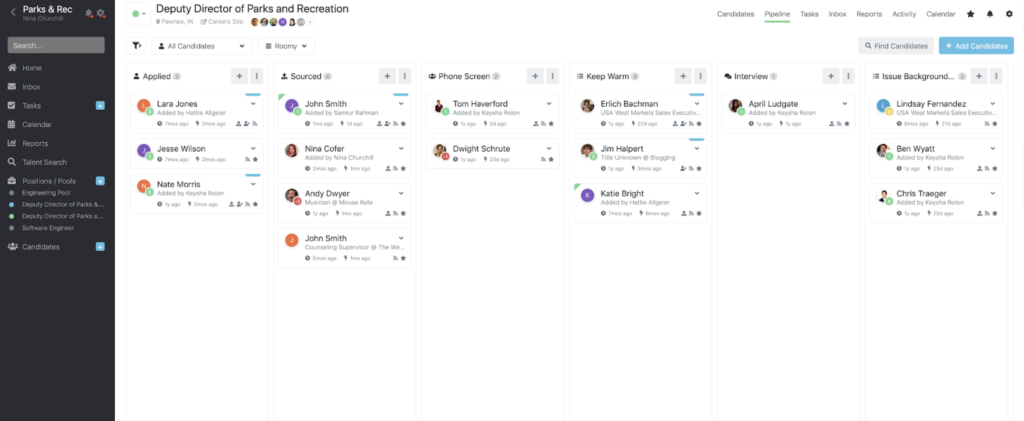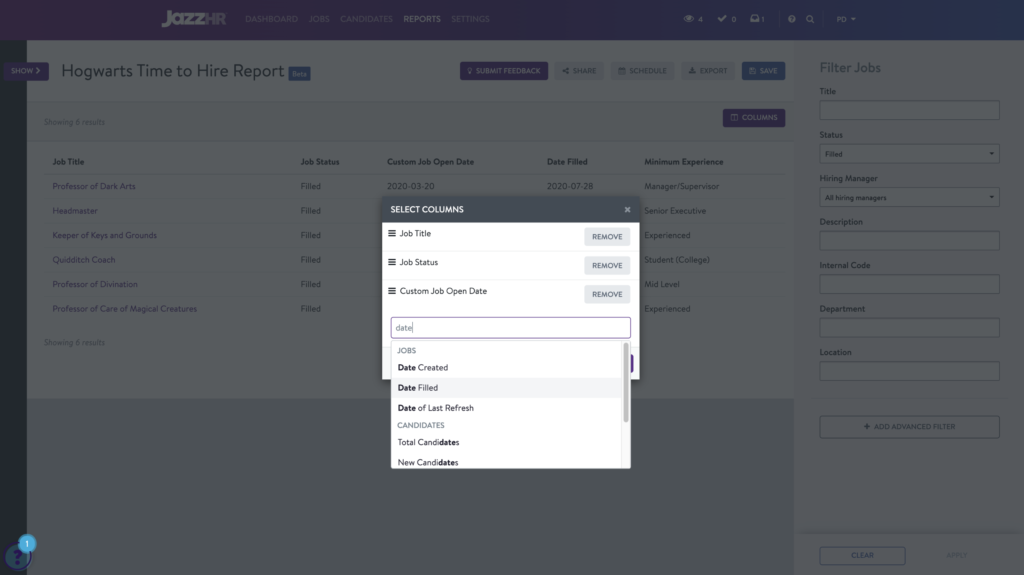The most effective recruiting software helps small business owners expand their candidate pools, promote their job openings more widely, and quickly screen applicants. Here are my top picks for small business recruiting software:
- Zoho Recruit: Best for affordability
- JazzHR: Best for beginners
- Workable: Best for extensibility
- Breezy HR: Best for candidate screening
- Recruitee: Best for on-the-go teams
Best recruiting software for small business 2024
Overall score
Use case
Starting price*
Learn more

Zoho Recruit
3.89
Best for affordability
$25 per recruiter per month, billed annually

Breezy HR
3.76
Best for candidate screening
$157 per month billed annually
* Starting prices are based on paid tiers.

Workable: Best for extensibility
Overall score
3.92/5.00
User scores
3.88/5.00
Pricing
3.38/5.00
Support
4.20/5.00
Platform interface
4.05/5.00
Applicant tracking features
4.06/5.00
Pros
- Lots of recruiting and HR features included on all plans.
- Wide selection of third-party integrations.
- Well-designed interface is visually appealing and easy to navigate.
- Can customer support via phone, email, or live chat.
Cons
- More expensive than some competitors.
- No free plan available.
Why I chose Workable
I chose Workable because it offers more than 280 integrations with third-party software, including payroll, background checks, performance management, and more. This extensibility means that Workable is highly likely to connect to any other business software that you currently have, or that you might start using in the future, so it can scale with your business. Workable also scored very highly in terms of its application features and customer support.

Zoho Recruit: Best for affordability
Overall score
3.89/5.00
User scores
4.06/5.00
Pricing
4.25/5.00
Support
3.63/5.00
Platform interface
3.63/5.00
Applicant tracking features
3.95/5.00
Pros
- Lots of customization options.
- Great balance of price and features.
- Forever free plan for one active job.
- Create and save your own job posting and pipeline templates.
- Paid plans get automatic search access to eight different job databases.
Cons
- No native e-sign capabilities (requires an integration with Zoho Sign).
- Hiring pipeline interface is not intuitive.
- Not enough ways to collaborate with stakeholders during the screening stage.
Why I chose Zoho Recruit
I selected Zoho Recruit as the best small business recruiting software for affordability because it offered the most bang for the buck out of all the software I tested, ranking a 4.25/5 for pricing. Not only does Zoho Recruit offer a forever free plan for one active job, it also charges a very reasonable price per user for the paid plans, making it a cost effective solution if you only need one or two people to access the software.

Breezy HR: Best for candidate screening
Overall Reviewer Score
3.76/5.00
User scores
4.17/5.00
Pricing
4.06/5.00
Support
2.25/5.00
Platform interface
3.55/5.00
Applicant tracking features
4.34/5.00
Pros
- Free forever for one active job listing.
- Unlimited open jobs on all paid plans.
- Connects to 50+ free jobs boards for sourcing candidates.
- Applicant screening tools available on all paid plans.
Cons
- No phone support available, even for the more expensive plans.
- Fewer integrations with third-party software than some competitors.
Why I chose Breezy HR
I chose Breezy HR because it offers great tools for candidate sourcing and screening at an affordable price. Not only does it offer a forever free plan for one active job, but it also provides unlimited job postings and candidates on its entry level paid plan (as opposed to most competitors, which limit you to 2-5 active jobs on the cheapest plans). The drag-and-drop pipelines make it super easy to either move candidates forward or disqualify them, and the hiring conversations module keeps all communication centralized in Breezy HR so stakeholders stay on the same page.

JazzHR: Best for beginners
Overall score
3.52/5.00
User scores
4.03/5.00
Pricing
3.19/5.00
Support
3.58/5.00
Platform interface
3.99/5.00
Applicant tracking features
3.15/5.00
Pros
- Logical layout is very easy to navigate, even for beginners.
- Fast calendar syncing for interview scheduling.
- Excellent reporting module.
- Includes offer letter templates and e-signature capabilities.
Cons
- Only the Pro plan gets phone support.
- Doesn’t have a mobile app for on-the-go recruiting.
- Difficult to customize the career page without coding knowledge.
Why I chose JazzHR
I chose JazzHR because it has a very simple and logical layout that is easy to navigate, even if you’ve never used an ATS before. Unlike some other platforms that overwhelm you with customizations or bury essential functions in random menus, JazzHR’s step-by-step interface makes it fast and easy to create and post a job, add candidates, and move them through the interview pipeline. The plug-and-plug modules require minimal training, saving SMBs owners time and hassle so they can focus on actually hiring candidates instead of doing admin work.

Recruitee: Best for on-the-go teams
Overall score
3.51/5.00
User scores
3.84/5.00
Pricing
2.81/5.00
Support
3.05/5.00
Platform interface
4.31/5
Applicant tracking features
3.44/5
Pros
- Well-designed interface with an easy-to-navigate layout.
- Mobile apps available for both iOS and Android devices.
- Internal jobs postings can be consolidated on an internal page.
- Highly customizable career page.
Cons
- No offer letter templates or e-signature capabilities.
- More expensive than some competitors.
- Doesn’t disclose customer service hours.
Why I chose Recruitee
I chose Recruitee because of its well-designed mobile apps, which are a must for SMB owners who are juggling recruiting alongside many other tasks. The mobile app will also benefit small businesses that attend many local job fairs or otherwise do a lot of their recruiting in person and on site. I also liked that Recruitee provides a highly customizable career page as well as a dedicated page for internal jobs only.




















